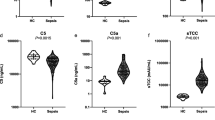Abstract
Fifteen premature newborns with hyaline membrane disease causing acute respiratory distress were evaluated for complement activation. A high intrapulmonary right-to-left shunt and marked arterial-alveolar oxygen difference indicated the severity of the respiratory failure. Twenty preterm healthy infants served as controls. Total haemolytic activity, plasma concentrations of complement components and regulatory proteins (C3, C4, C1-inhibitor, factors H and I) as well as activation products (C3a, C3dg, C1rsC1-inhibitor, C3b(Bb)P) gave no evidence of significant complement activation. Functional activity of the ubiquitous regulatory protein C1-inhibitor was significantly reduced without impact on classical pathway activation. These data suggest that, in contrast to the adult form of respiratory distress syndrome, the low-pressure pulmonary oedema characterising hyaline membrane disease is not mediated by activation of the complement system.
Similar content being viewed by others
Abbreviations
- ARDS:
-
adult respiratory distress syndrome
- C1-inh:
-
C1-inhibitor
- CH50:
-
haemolytic activity
- HMD:
-
hyaline membrane disease
References
Albert RK, Lakshminarayan S, Hildebrandt J, Kirk W, Butler J (1979) Increased surface tension favors pulmonary edema formation in anesthetized dogs' lungs. J Clin Invest 63:1015–1018
American Academy of Pediatrics — Committee on Fetus and Newborn (1967) Nomenclature for duration of gestational birth weight and intrauterine growth. Pediatrics 39:935–939
Avery ME, Fletcher BD, Williams RG (1981) The lung and its disorders in the newborn infant. WB Saunders, Philadelphia, pp 228–237
Bland RD (1987) Pathogenesis of pulmonary edema after premature birth. Adv Pediatr 34:175–222
Brandslund I, Siersted HC, Svehag SE, Teisner B (1981) Doubledecker rocket immunoelectrophoresis for direct quantitation of complement C3 split products with C3d specificities in plasma. J Immunol Methods 2:63–71
Burger R, Zilow G, Bader A, Friedlein A, Naser W (1988) The C terminus of the anaphylatoxin C3a generated upon complement activation represents a neoantigenic determinant with diagnostic potential. J Immunol 141:553–558
Davis CA, Vallota EH, Forristal J (1979) Serum complement levels in infancy: age related changes. Pediatr Res 13:1043–1046
Duchateau L, Hass M, Schreyen H, Radoux L, Sprangers I, Noel FX, Braun M, Lamy M (1984) Complement activation in patients at risk of developing the adult respiratory distress syndrome. Am Rev Respir Dis 130:1058–1064
Effmann EL, Merten DF, Kirks DR, Pratt PC, Spock A (1985) Adult respiratory distress syndrome in children. Radiology 157:69–74
Faix G, Viscardi RM, DiPietro MA, Nicks JJ (1989) Adult respiratory distress syndrome in full-term newborns. Pediatrics 83:971–976
Farrel PM, Avery ME (1975) Hyaline membrane disease. Am Rev Respir Dis 111:657–687
Hammerschmidt DE (1983) Activation of the complement system and of granulocyte in lung injury: the adult respiratory distress syndrome In: Weissmann G (ed) Advances in inflammation research, Vol. 5. Raven Press, New York, pp 147–172
Jefferies AL, Coates G, O'Brodovich H (1984) Pulmonary epithelial permeability in hyaline membrane disease. N Engl J Med 311:1075–1080
Jobe A, Ikegami M, Jacobs H, Jones S, Conaway D (1983) Permeability of premature lamb lungs to protein and the effect of surfactant on that permeability. J Appl Physiol 55:169–176
Kitajima H, Fujimura M, Takeuchi T, Miyano A, Nakayama M, Fujita T, Imai S, Shimizu A (1990) Effect of amnionitis on the complement system of preterm infants. Early Hum Dev 21:59–69
Langlois PF, Gawryl MS (1988) Complement activation occurs through both the classical and alternative pathways prior to onset and resolution of adult respiratory distress syndrome. Clin Immunol Immunopathol 47:152–163
Levy LR, Lepow IH (1959) Assay and properties of serum inhibitor of C1 esterase. Proc Soc Exp Biol 101:608–611
Lyrene RK, Truog WE (1981) Adult respiratory distress syndrome in a pediatric intensive care unit: predisposing conditions, clinical course and outcome. Pediatrics 67:790–795
Mayer MM (1961) Complement and complement fixation. In: Kabat E, Mayer MM (eds) Experimental immunochemistry. Charles C Thomas, Springfield, pp 133–240
Nürnberger W, Stanningel H, Müntel V, Michelmann I, Wahn V, Göbel U (1990) In-Vivo-Aktivierung der vierten Komponente des Komplementsystems (C4) bei Früh- und Reifgeborenen mit generalisierten bakteriellen Infektionen. Klin Paediatr 202:141–146
Pfenninger J, Gerber A, Tschäppeler H, Zimmermann A (1982) Adult respiratory distress syndrome in children. J Pediatr 101:352–357
Raffin TA (1987) ARDS: Mechanisms and management. Hosp Pract 22:65–86
Rinaldo JE, Rogers RM (1986) Adult respiratory distress syndrome. N Engl J Med 315:578–579
Royall J, Levin DL (1988) Adult respiratory distress syndrome in pediatric patients. I. Clinical aspects, pathophysiology, pathology and mechanisms of lung injury. J Pediatr 112:169–180
Saugstad OD, Harvie A, Langslet A (1982) Activation of the kallikrein-kinin system in premature infants with acute respiratory distress syndrome (RDS). Acta Pediatr Scand 71:965–968
Schrod L, Frauendienst-Egger G, Stockhausen HB von, Kirschfink M (1992) Plasma C3a in asphyxiated neonates. Eur J Pediatr 151:688–692
Shapiro R, Beatty DW, Woods DL, Malan AF (1981) Serum complement and immunoglobulin values in small-for-gestational-age infants. J Pediatr 99:139–141
Skorodin MS (1984) Respiratory distress and A-a gradient measurement. JAMA 252:1344
Strang LB (1978) Heterogeneity of pathogenetic mechanisms in hyaline membrane disease. Mead Johnson Symposium on Perinatal and Development Medicine, pp 53–58
Zilow G, Burger R, Stuthe M, Zilow EP (1990) Increased C3a-des Arg concentration as indicator for neonatal infections. Immunobiology 181:250
Zilow G, Sturm JA, Rother U, Kirschfink M (1990) Complement activation and the prognostic value of C3a in patients at risk of adult respiratory distress syndrome. Clin Exp Immunol 79:151–157
Author information
Authors and Affiliations
Rights and permissions
About this article
Cite this article
Cat, R., Rosario, N.A., Taborda de Messias, I. et al. Evaluation of complement activation in premature newborn infants with hyaline membrane disease. Eur J Pediatr 152, 205–208 (1993). https://doi.org/10.1007/BF01956145
Received:
Accepted:
Issue Date:
DOI: https://doi.org/10.1007/BF01956145




